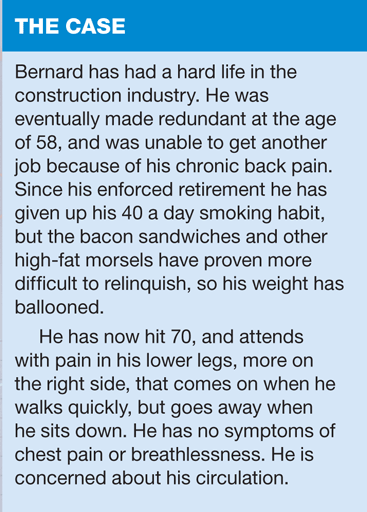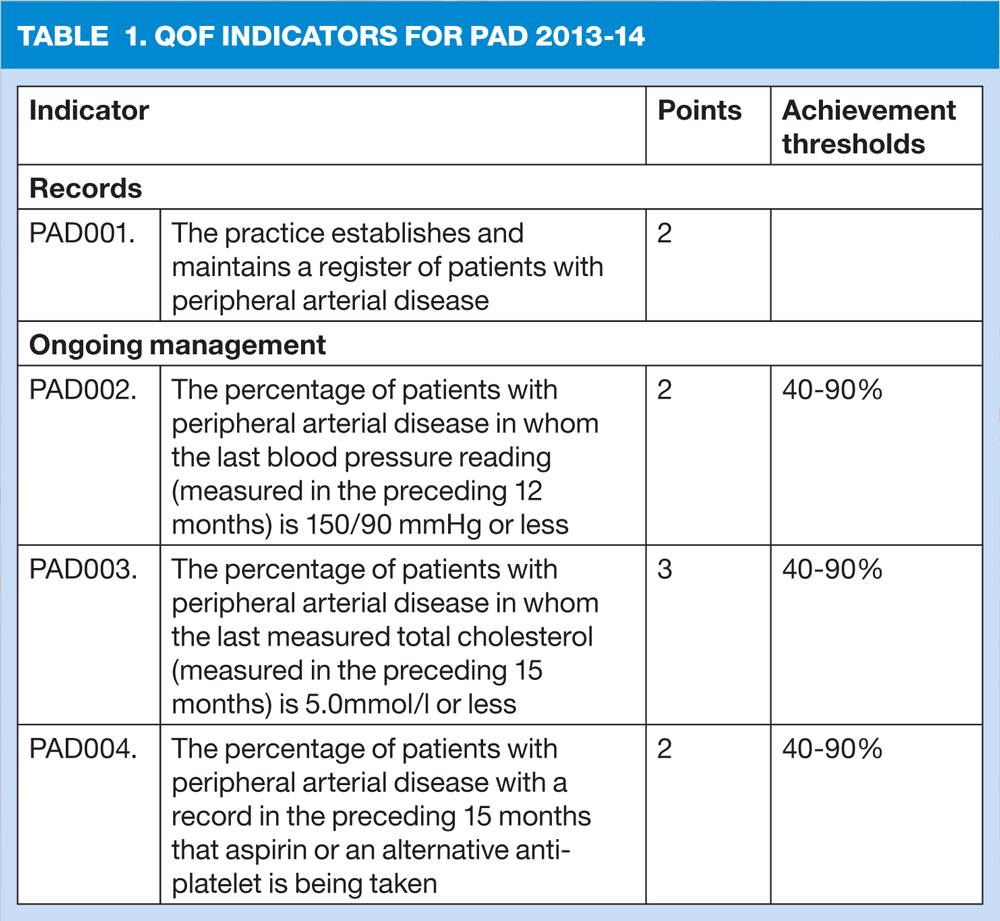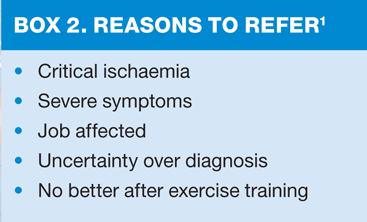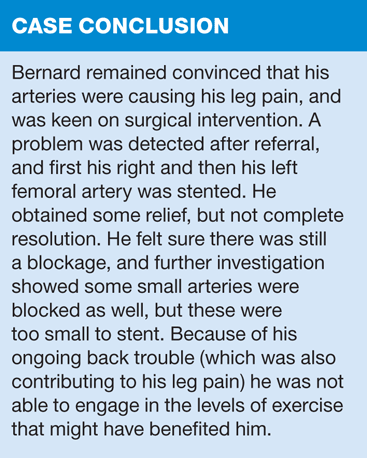Ten things the practice nurse can do about Peripheral Arterial Disease
Dr Ed Warren
Dr Ed Warren
FRCGP
GP trainer, Barnsley VTS
Peripheral arterial disease is common, painful and can become a medical emergency. Our guide provides practical advice on the detection, diagnosis and early management of this condition
Peripheral blood vessels are the veins and arteries in the arms and legs. Legs generally cause more trouble than arms and, with the possible exception of varicose veins, arteries cause more trouble than veins.
Leg arteries are like any other arteries, and can gradually become blocked with plaque deposits. When this happens to arteries in the heart, it causes angina and heart attacks. When it happens to cerebral arteries, it causes stroke. Peripheral Arterial Disease (PAD) is very strongly associated with other arterial disease, and indeed PAD sufferers are more likely to die of stroke or heart attack than they are to die from PAD. The management of PAD has to take due account of the likelihood of other arterial atheroma.
PAD is therefore an important condition. It causes pain and disability. It is a flag for other arterial disease. And there is an array of Quality and Outcomes Framework (QOF) targets to be met. Your practice may well have a specific PAD clinic. It will almost certainly have clinics for stroke, ischaemic heart disease, diabetes and hypertension: these patient groups are also at risk of PAD.
The commonest symptom of PAD is intermittent claudication. Reduced blood supply to the legs means that, on exertion, there is not enough blood to remove the anaerobic metabolites that build up and cause pain. Typically pain occurs in the calves, but the thighs and buttocks can also be involved, depending on where the arterial obstruction is located. Pain comes on gradually with walking, and settles promptly on resting. These symptoms are not really typical of any other condition, so getting a good history is the best way of establishing the diagnosis.
The ‘claudication’ of intermittent claudication (IC) is allegedly named after the Roman emperor Claudius who walked with a limp.
Risk factors for intermittent claudication1
- Gender – men more than women
- Smoking
- Obesity
- Hypertension
- High cholesterol
- Diabetes
- Physical inactivity
- Menopause
The prevalence of IC is strongly age-related. It is found in 4% of the over 50s and 5% of the over 65s. In addition, most PAD is asymptomatic, so that overall 20% of the over 65s and 30% of the over 85s are affected.2–4 This is important as asymptomatic sufferers have a substantially increased risk of cardiovascular disease.5 A patient with PAD has a 50% chance of being dead within 10 years: in 60% of cases due to myocardial infarction, and in 12% of cases due to stroke.2
MAKING THE DIAGNOSIS
PAD is usually diagnosed from the typical history of leg muscle pain on exertion. The muscle affected depends on which artery or arteries are impeded. A narrowing of the popliteal artery (the pulse behind the knee) causes IC of the calf; the femoral artery (the pulse in the groin) affects the calf and thigh; a blockage in the aorta or iliac arteries (which are intra-abdominal) causes IC of the calf, thigh and buttock.
Bernard has a typical history for IC because of the symptom pattern, his age, obesity, previous smoking habits and fatty diet. However he also has chronic back pain: spinal stenosis is a compression of the spinal cord caused (usually) by spinal degeneration, but that too can cause leg pain on walking that abates with rest. If the back were causing his leg pain, you would expect Bernard to have some back tenderness, possibly changes to his reflexes, and a variation in symptoms with posture.
IC is the most characteristic symptom pattern in PAD. Some people are at increased risk of PAD and would benefit from an arterial assessment even without IC, including those with:
- Diabetes
- Non-healing wounds on legs or feet
- Unexplained leg pains
- Need to use compression hose (if the arterial pressure is low this may be compromised by the stockings)6
Absent or reduced leg pulses reinforce the diagnosis of PAD. The femoral pulse is easy to feel in the groin: it is probably the strongest pulse in the body (and would no doubt be felt more often were it not rather inaccessible under normal clothing). The dorsalis pedis is probably the most useful for our purposes as its absence might be attributable to an arterial blockage anywhere from the aorta downwards. It is felt on top of the bones on the upper side of the foot: you put your fingers on an imaginary line between the gap between the first and second toes, and the midpoint between the knobbly bones on either side extremity of the ankle.
A more sophisticated test, not available in every surgery, is to measure the Ankle Brachial Pressure Index (ABPI). This is the ratio of arterial pressure in the ankle compared with that in the arm. An ordinary blood pressure cuff is used, but instead of a stethoscope, a Doppler probe ‘listens’ for the pulse. An obstetric Doppler can be used, but it needs a specific probe to work properly. Ask your patient to lie down flat for 10 minutes – the test has to be done with the patient lying down. Take the blood pressure in each arm using the Doppler (you will also need the gel): locate the elbow artery (the brachial), inflate the cuff until the sound goes, then let the pressure out slowly until the sound reappears and then disappears again. You need to record the upper, systolic reading (as the sound appears), and also to use the higher of the readings in each arm – there is usually some difference between the left and right. Then remove the cuff and put it round your patient’s ankle. You will need to locate the posterior tibial artery which wraps around the back of the medial malleolus (the knobbly ankle bone on the inside) or the dorsalis pedis. Again measure the systolic pressure. The ABPI is the ankle pressure divided by the arm pressure.
If the ABPI is between 0.9 and 1.3 then PAD is not confirmed, and if symptoms are typical a referral to hospital may be needed to investigate further. An ABPI between 0.5 and 0.9 confirms PAD. An ABPI below 0.5 suggests severe PAD and possibly critical ischaemia (see Box 1) – tell one of your doctors. An ABPI over 1.3 can occur in patients with diabetes, or in patients with so much atheroma that the arteries have become stiff and are not distorted as the cuff is inflated.
A demonstration of measuring ABPI is available on YouTube, at: http://www.youtube.com/watch?v=5Wclloi-qjU)
Arterial atheroma is usually a progressive condition, so you would expect patients with IC to get worse with time. However, over a period of 5 years, 70–80% stay the same, 10–20% will get worse and 5–10% will develop critical ischaemia, with pain at rest, and ankle blood pressure below 50mmHg. This is a medically urgent situation when your patient is in danger of gangrene and amputation.7
WHAT TO DO
1. Provide information
Treating PAD requires lifestyle changes. These cannot be imposed, but are more likely to be effective where your patient understands and takes responsibility for his or her own wellbeing. The information offered must take account of the individual’s information wishes, and their particular circumstances. Suggestions include:
- The cause of the symptoms and the severity of the disease
- The risk of limb loss and cardiovascular risks of the PAD
- Modifiable risk factors (see later)
- Managing the pain
- Treatment options, advantages and disadvantages
- Dealing with depression and anxiety6
2. Address smoking
Some risk factors for PAD cannot be altered: history of angina or heart attack; history of stroke or TIA; age; ethnicity; family history; diabetes; impaired glucose tolerance; gender. These are all important but cannot be changed (though risk is reduced by getting diabetes under optimum control). It is tempting for practitioners to concentrate on the things which can be changed. However, keep in mind that some patients will comply with all the risk reduction advice you give, and still end up with symptomatic PAD or an amputation. It is not fair for the healthcare professional to also impose a burden of guilt on them for their plight.
That said, smoking must be addressed. The prevalence of smoking among PAD patients is likely to be higher than average: indeed they probably would not have PAD if they had never smoked. See Smoking Cessation – tailoring your approach to the individual smoker, Practice Nurse, October 2013 for how to provide effective smoking cessation advice in primary care.8
3. Advise on diet and weight management
People who consume a high calorie and high fat diet are more likely to get PAD. Being overweight is a risk because it affects how the body deals with sugar (risking diabetes, or a pre-diabetic state), because it increases blood pressure and cholesterol. Also consider the mechanics: an overweight person is less likely to take sufficient exercise because the effort of doing so while carrying excess weight makes exercise deeply unpleasant; furthermore, in people who are overweight, the leg muscles have to work harder and are more likely to have an inadequate blood supply.
So overweight patients with PAD should be offered any help available. Many patients will jump at a chance for assistance in this respect, partly to help the symptoms, partly because of a desire to lose weight, and partly because radical gastric surgery seems to have become a lifestyle choice. Help may include referral to a weight management programme that the NHS may be funding in your area. Commercial weight management programmes may also be effective, but will be more expensive. The medication orlistat is licensed for assistance in weight loss.
4. Encourage exercise
In England only about 40% of men and 28% of women take sufficient exercise for their health and welbeing.9 These are self-reported exercise levels, and so the true figures will probably be lower. Exercise protects against PAD, but recommended levels of exercise are quite demanding: 150 minutes of moderate exertion or 75 minutes of vigorous exertion, in bouts of 10 minutes or more, plus two episodes of muscle strengthening, spread across a week. People should also try to spend less time sitting down.9
It is also suggested that people with IC undergo exercise which will bring on their pain.6 The idea is that this will encourage the development of collateral circulation that will bypass any blockage. So they should walk until the pain comes on, and then carry on and – if possible – walk through the pain. This will not be a popular suggestion because it hurts, and because in most peoples’ perception pain is equated with damage being done, so pain should be avoided. Apparently the writer John Mortimer was once asked whether he got breathless on exertion, to which he replied: ‘How would I know?’
5. Target cholesterol
People with PAD have proven arterial disease and so require secondary prevention. There is evidence of benefit from taking a statin in PAD if the total cholesterol exceeds 3.5 mmol/l.10 Treating cholesterol greater than 3.5 mmol/l is recommended by the Scottish Intercollegiate Guidelines Network (SIGN)11 – well below the target cholesterol level of 5 mmol/l suggested by the QOF.
6. Optimise diabetes management
Diabetes is a risk factor for arterial atherosclerosis. Because diabetes also causes neuropathy, people with PAD and diabetes are at particular risk of skin ulcers, infections and amputations. Good glycaemic control reduces the risk, but other risk factors should also receive meticulous attention. An annual assessment of foot pulses in diabetes is a QOF requirement and also good clinical practice.
7. Review hypertension therapy
Patients being treated for hypertension should be checked every year to establish their coronary risk, as hypertension is one more thing that promotes atherosclerosis. Beta-blockers are rather out of fashion in hypertension treatment, but they used to be thought of as a bad idea in PAD because they can cause arterial restriction. While this fear is probably misplaced, it is an opportunity to review current antihypertension therapy.
8. Consider antiplatelets
It is suggested that patients with PAD should take low dose aspirin. This makes sense, as there is evidence of arterial disease, and antiplatelet therapy reduces the risk of heart attack by about a quarter. Alternatives are clopidogrel (which may work slightly better than aspirin), and dipyridamole.1
9. Refer to secondary care
As PAD is due to arterial blockage, and vascular surgeons can do amazing things with bypasses and stents, it would seem logical to conclude that every patient with PAD would benefit from a referral. However this is not necessarily the case.
Critical ischaemia is claudication at rest or after walking a very short distance. Rest pain is frequently worse at night when lying as gravity is not available to assist arterial perfusion. There may be skin necrosis or ulceration. ABPI is very low or unrecordable, and the ankle pressure may be under 50mmHg. This situation (sometimes memorised by the ‘6 Ps’, see Box 1), is an emergency usually requiring admission to hospital. Reasons to refer are summarised in Box 2.
10. Wait and see
For other sufferers, a period of treatment in primary care is a good idea, reserving referral for later if needed. Good quality secondary prevention measures can be instituted, and do not require referral – indeed, we are doing this all the time for our heart attack and stroke survivors. Some practitioners will feel comfortable using newer medications for PAD. Exercise training can be started, though most patients will need regular encouragement.
CONCLUSION
PAD is yet one more manifestation of atherosclerosis. Sufferers are at risk of amputations, but at much more risk of stroke or heart attack. IC is the main symptom pattern of PAD, but many sufferers have no symptoms at all, yet remain at increased risk. Secondary prevention is required, of the sort used in a widespread way for ischaemic heart disease. Diabetes requires diligent attention.
Practice nurses will see endless people at risk for PAD because of their work with ischaemic heart disease, stroke, hypertension and diabetes. PAD has also come under the scrutiny of the QOF. Be aware of the telltale signs that PAD may be brewing.
REFERENCES
1. Simon C, Everitt H & Kendrick T. Oxford Handbook of General Practice. Oxford Medical Publications:Oxford 2007
2. Tierney S et al. ABC of Arterial and Vascular Diseases. BMJ 2000;320:1262-5
3. Hirsch AT, et al. Peripheral arterial disease detection, awareness and treatment in primary care. JAMA 2001;286(11):1317-24
4. Fowkes FG, et al. Edinburgh Artery Study. Int J Epidemiol 1991;20(2):384-92
5. Fowkes FG, et al. Targeting subclinical atherosclerosis. BMJ 1998;316:1764.
6. NICE. Lower limb peripheral arterial disease: diagnosis and management. NICE Clinical guideline 147. August 2012 http://www.nice.org.uk/nicemedia/live/13856/60428/60428.pdf Accessed November 2013
7. NICE guidance points the way to better diagnosis and management of common cardiovascular condition. NICE press release August 2012. http://www.nice.org.uk/newsroom/ pressreleases/ NICEGuidancePoints TheWayToBetterDiagnosisAnd ManagementOfCommonCardiovascularCondition.jsp Accessed November 2013
8. Attar-Zadeh D. Smoking cessation – tailoring your approach to the individual smoker. Practice Nurse, October 2013;43(10):18–22
9. Department of Health. Start Active, Stay Active. http://www.dh.gov.uk/prod_consum_dh/groups/dh_digitalassets/documents/digitalasset/dh_128210.pdf Accessed November 2013
10. NICE. Lower limb peripheral arterial disease: diagnosis and management. NICE Clinical guideline 147. Full guidance. August 2012 http://www.nice.org.uk/nicemedia/live/13856/60426/60426.pdf Accessed November 2013
11. SIGN 89. Diagnosis and management of peripheral arterial disease. October 2006. Available at: http://www.sign.ac.uk/pdf/sign89.pdf. Accessed November 2013
Related articles
View all Articles




